Cookery Feature - Grow & Cook!
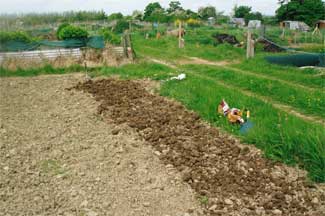 A really encouraging thing is happening all over Ireland at the moment: growing-your-own is back in style. And, although there’s a touch of ‘Digging for Victory’ about the unlikely places that are being turned into productive gardens, it isn’t just about beating the recession or keeping costs down, but more to do with a return to reality and care about quality food and where it comes from – and, of course, the challenge of beating the slugs and snails, and everything the Irish weather can throw at us.
A really encouraging thing is happening all over Ireland at the moment: growing-your-own is back in style. And, although there’s a touch of ‘Digging for Victory’ about the unlikely places that are being turned into productive gardens, it isn’t just about beating the recession or keeping costs down, but more to do with a return to reality and care about quality food and where it comes from – and, of course, the challenge of beating the slugs and snails, and everything the Irish weather can throw at us.
If you don’t believe it, the surging demand for allotments is testimony to the nation’s new taste for growing our own food (my son Bob is into his second year as an allotment holder, and will be telling us all about it – when he can find the time!) Waiting lists for allotments are long, alas, but you don’t need to have a big space (or a garden at all) to have the satisfaction of growing food for your own table.
We don’t have a big garden, but it’s amazing how much you can get just by setting aside a bit of space in an average suburban back garden – we have a Bramley apple tree, Conference pears grown against a wall and a couple of (sort of) espalier-trained eating apples; and as well as rhubarb, herbs and saladings, we always have runner beans (fantastic returns from a small space as long as they’re well fed and watered and have plenty of light; you can even get a kit for growing them on a balcony - and they’re pretty too), early broad beans, mangetout and French beans, plus tomatoes (easier than you think – and you can get outdoor trailing varieties to grow in hanging baskets), strawberries, courgettes and whatever else is the fancy of the season (Alpine strawberries, perhaps).
 Home grown potatoes are irresistible, but take up a lot of space in the ground – I grew a surprisingly big crop of earlies successfully in a half barrel last year and, having been given a commercial ‘potato barrel’ by Bob & his wife Laura for Christmas, am now trying a system that allows you to begin with just five seed potatoes – the aptly named ‘Epicure’ in our case - and earth them up in a vertical column; then (if it does what it says on the flatpack) it will be crammed full of new potatoes by mid summer.
Home grown potatoes are irresistible, but take up a lot of space in the ground – I grew a surprisingly big crop of earlies successfully in a half barrel last year and, having been given a commercial ‘potato barrel’ by Bob & his wife Laura for Christmas, am now trying a system that allows you to begin with just five seed potatoes – the aptly named ‘Epicure’ in our case - and earth them up in a vertical column; then (if it does what it says on the flatpack) it will be crammed full of new potatoes by mid summer.
A big weakness for me is Jerusalem artichokes, which are members of the sunflower family and easily grow to 12 feet – not the best choice for a small garden, but we always find somewhere for them and what a treat they are through the winter.
Brassicas are generally too big and awkward for a small space, but I do love purple sprouting broccoli and, as it’s surprisingly difficult to find in the shops, it’s worth the effort – and not as mad as it sounds, as you don’t need to move the young plants into their final position until other crops have finished in the autumn, when space isn’t such an issue. But be warned – this hobby is addictive; once hooked you’ll never want a purely ornamental garden again!
The joy of it all really is that you can try things that aren’t easy to get in the shops – OK, not everyone has the space for asparagus bed, but imagine having a supply of proper seasonal asparagus instead of those universal spears that come from South America. Visiting the oldest son, Brian, in Geneva a while back, a vivid memory is of restaurants in the city offering ‘asparagus menus’ in spring – once tasted, never forgotten.
And then, most importantly - I’ve never been able to understand why small organic growers don’t make more of this – you can grow named varieties, and find the ones that are most reliable for your soil and aspect. And, of course, with the most flavour…
Seeking out the best gardening/seasonal cookery books can be addictive too – the classics will always earn their shelf space, and there are useful new books coming along all the time, including Allan Shepherd’s practical and encouraging The Organic Garden, Green and Easy (HarperCollins, stg£12.99) which is ideal for anyone who wants to garden (and shop at garden centres) ethically; the same principles apply to Grow and Cook (Gill& Macmillan, €24.99) by well known Irish husband-and-wife team Tom and Joahann Doorley, who are lucky enough to have an old walled garden in East Cork… And viewers who have been watching ethno-botanist James Wong’s ‘Grow Your Own Drugs’ (HarperCollins, £16.99), will know that, despite the dodgy title, this is an informative gardening/foraging/cooking guide to making the most of common garden and hedgerow plants to help with minor everyday ailments and beauty treatments.
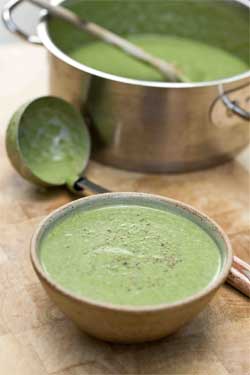 Nettle Soup & Nettle Pesto
Nettle Soup & Nettle Pesto
This pretty spring soup from Grow Your Own Drugs is described as a ‘Restorative’, and it was traditional in Ireland for ‘cleansing the blood’ after the dark months of winter. Nettles (urtica dioica) are at their best in spring when the fresh young growth is tender, tasty and packed with nourishing vitamins, minerals and chlorophyll, helping to build up natural immunity and protect from infections after the winter You don’t have to grow nettles, of course, they do it very well all by themselves – and can safely be picked from clean hedgerows away from busy roads, and where they will not have been sprayed. While Nettle Pesto is another simple, tasty way to get the benefits of urtica dioica.
Click Here for Recipes
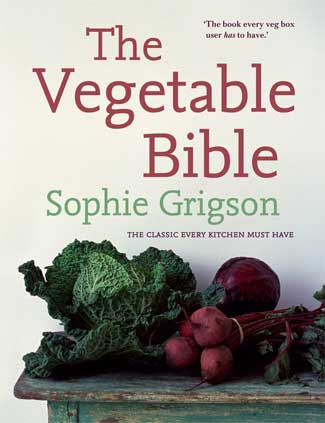 Broad Bean, Dill and Saffron Pilaff
Broad Bean, Dill and Saffron Pilaff
Sophie Grigson has been championing vegetables throughout her food writing career (one of her early successes was Eat Your Greens). In this dish from The Vegetable Bible (HarperCollins, stg£15), shades of fresh spring green, yellow and white ‘look like Easter’. To get it at its best Pascal prettiness you do have to take a little time over preparing the broad beans, but Sophie assures us that they'll taste all the better for it. Early broad beans are ready in May-June, but you can make this at any time with frozen beans - like peas, they freeze exceptionally well. Serve as a light main dish, or as a side dish (in which case you don't really need the yoghurt).
Click here for recipe
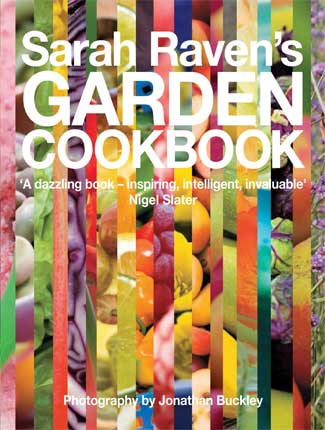 Poached Rhubarb with Stem Ginger Ice Cream
Poached Rhubarb with Stem Ginger Ice Cream
Fans of BBC’s Gardeners’ World will be familiar with Sarah Raven’s magnificent garden, and this remarkable gardener (who always seems to be immaculately dressed – in a skirt!) was also a guest tutor at Ballymaloe Cookery School earlier this year. The stunning seasonal Sarah Raven’s Garden Cookbook (Bloomsbury, £30) makes an ideal companion for her earlier book The Great Vegetable Plot, and will surely inspire the most jaded cook to grow and cook, or at least to shop in season. Tender early stems of rhubarb are perfect for this recipe, although it can be made all season; rhubarb is one of the easiest crops to grow and it’s well worth finding a corner where you can leave a clump to get on with it, with very little attention needed from you. Just a little treacly muscovado sugar is enough to retain the slight sourness to contrast with the sweet ice cream.
Click for recipe
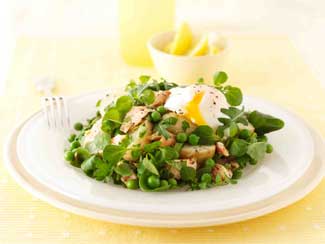 Warm Salad of New Potato, Pea and Trout with Poached Egg
Warm Salad of New Potato, Pea and Trout with Poached Egg
A lovely spring-into-summer warm salad to look forward to when you harvest your first crop of little new potatoes (very different from those all-year ‘baby’potatoes masquerading as ‘new’), and perhaps your own fresh peas (or mangetout), which are easily grown in small spaces if you choose dwarf varieties; out of season, frozen peas can be used instead as they freeze very well. American land cress is easily grown and can be used instead of watercress, if wished; likewise spinach beet (perpetual spinach) is easier to grow than true spinach.
Click for recipe





There are currently no comments
Leave a comment
Not a member? Register for your free membership now!
Or leave a comment by logging in with: